Men’s fashion takes different approaches depending on where you are. In the UK, they wear trousers, not pants. They’re cuffed to show off trainers, not sneakers. And when those shoes are no longer clean, we (those of us in the UK) toss them in the bin, rather than the trash.
But there’s one US import gladly welcomed everywhere. However, you may be surprised that these types of wingtip shoes for men are so British you could serve it with bacon and beans.

TL;DR
Across the Atlantic, the ‘full brogue’ becomes the ‘wingtip.’ Both denote a shoe that, as our prosaic term doesn’t suggest, features a leather ‘W’ at the toe that echoes a bird seen mid-beat. A pair of wings, at the tips of your shoes. Wingtips. Thank you, land of Hemingway.
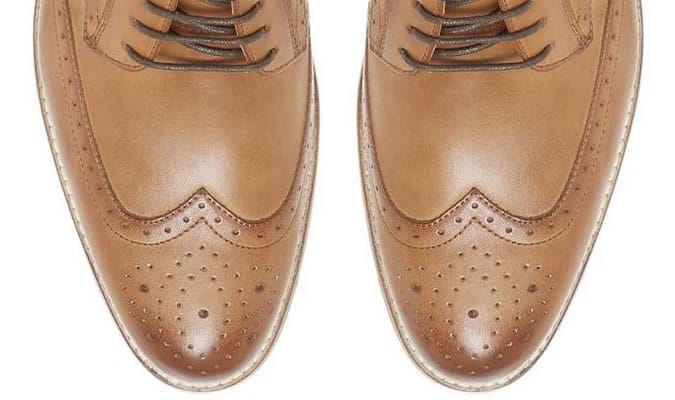
We prefer ‘wingtip’ not just for its poetry. The term also offers some much-needed specificity. Men’s footwear styles are awash in interlocking and often contradictory definitions. Broguing, for example, properly refers only to the holes punched in the toes, though it is often used to mean any shoe with detailing. Equally, it’s possible to find wingtips without broguing – a smooth toe cap, but still with that swoop of leather toward the heel. They are known, confusingly, as austerity brogues.
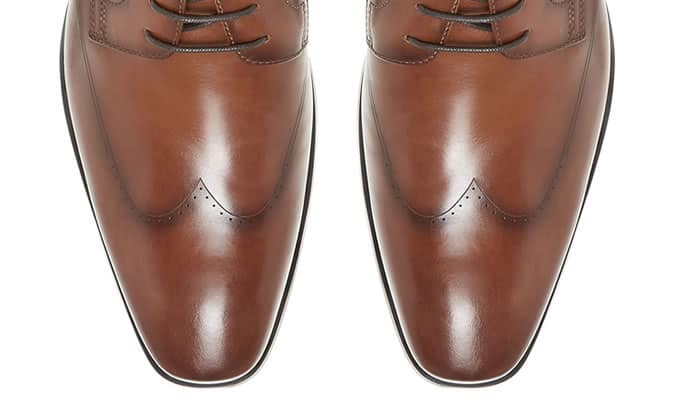
Actually wearing them is, thankfully, rather simpler. “Although they are a traditional style, wingtips must be the most versatile shoe ever,” says Andrew Loake, head of the eponymous Northampton shoemaker.
The devil is in the detailing. Their extra texture makes wingtips a mite more casual than plain lace-ups, so they’re happy sat beneath your dark denim as well as your suit. “We don’t find there’s a specific man that wears wingtips,” adds Loake. “In decades gone by they looked good with Oxford bags and now they’re equally good with skinny jeans.”
The Different Types Of Wingtip Shoes
Modern wingtips are a world removed from bog waders. They’re now a wardrobe essential and, as befits any menswear staple, have been twisted into new and occasionally unrecognizable shapes.
Classic Wingtips
As with any leather shoes, black is smartest, then browns from light to dark, with colors the most casual. The same goes for detailing; less is more versatile whereas intricate broguing, or novel leathers, tend not to work for smart get-ups.
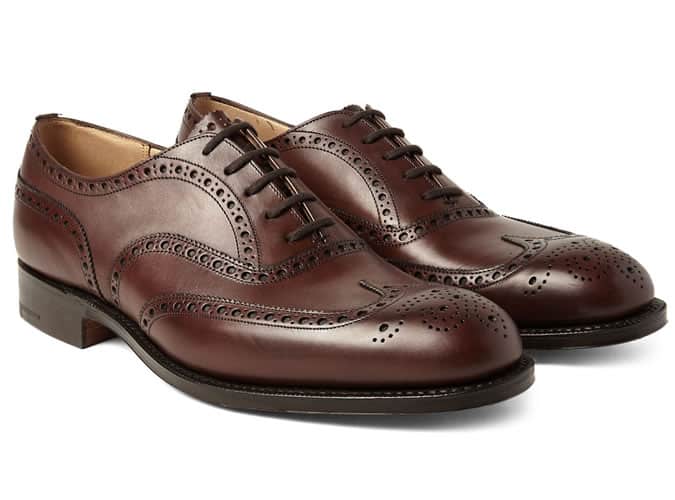
Longwings
The wingtip has a cousin, whose uniqueness is only noticeable from behind. “On a classic wingtip, the wing comes along the side of the shoe and dips down into the sole about half way along the shoes,” says Little. “On a longwing, the wing comes along the side of the shoe, all the way to the back.”

Austerity Brogues
As mentioned, these are wingtips with no broguing. Since they’re plain, they dress up a touch further, although they’ll still look just as good with jeans.

Wingtip Boots
Exactly the same as normal wingtips, but they continue above the ankle. As with any brogue wingtip boots, they’re more casual so work best with casual trousers or split suits.

Spectator Shoes
These are wingtips in contrasting colors – one shade of leather for the toe cap, another for the rest of the brogue. “Two-tone versions are taken from colonial references,” says Kirkby. They were big in the 1920s, although even then they were considered flamboyant. These days they tend to drag the eye from everything else you’re wearing, so should be worn with care.

Wingtips With A Twist
The last couple of seasons have seen a resurgence in classic styles, as brands from
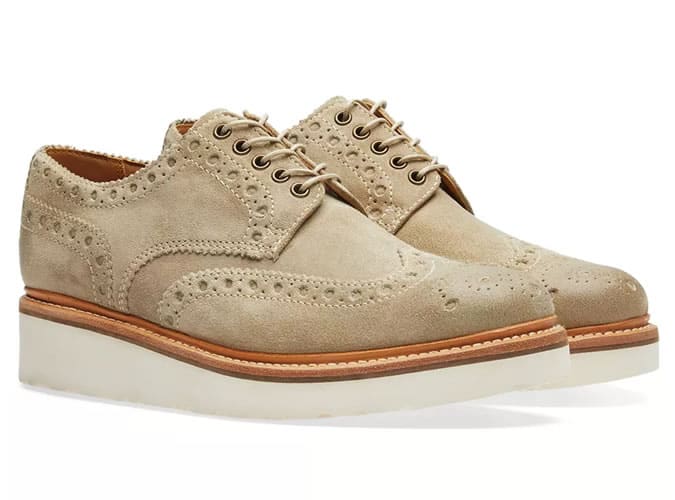
Buying a Pair of Wingtip shoes? Consider These Things First
A pair of wingtips will work with almost anything, if you buy right. And don’t be shy about opening your wallet; it’s an area of your wardrobe where every pound pays back dividends. If you spend a bit extra you’ll be more comfortable, more stylish and your shoes could last more than a decade. These are the key things to look out for.
The Soles
“They should have a Goodyear welting construction,” says Loake. “A traditional style should be made the traditional way.” It also makes your shoes hardier and means you can swap the soles out easily when they get worn, rather than tossing the entire shoe after a year.
The Upper
If they’re not leather, move on. There’s a reason it’s been the material of choice for centuries – it’s hard-wearing but breathable and ages beautifully over time. If you’re after something more casual, try suede, says Kirkby. Just check the forecast first.
The Wingtip
The curved leather is tougher to stitch that a straight toe, so inspect how neat the work is as a barometer of quality. “The balance of the style is critical,” says Kirkby. “Look for the correct spacing from the toe section to the lace section.” Beware styles that look cramped or overly airy.
How To Take Care of Wingtips Shoes
Like any leather shoes, wingtips pay back what you put in. Treat them well and you could even hand them down to your kids.
Prep The Soles
Leather soles are smarter but take a bit more looking after. “Try to wear them in dry conditions on the first few occasions,” says Loake. “The fine grit picked up by dry leather soles assists water resistance.”
Dry Them Out
You may love your new wingtips, but don’t wear them back-to-back. “Fine leather shoes can require a full day to dry out from natural perspiration,” says Loake. “Try to give them at least 24 hours between wears.” If they don’t dry, the leather can warp, which will cause damage that can’t be reversed. The same’s true if you get caught in a storm. Just keep them away from radiators – rapid drying is the quickest way to wreck your shoes. “Newspapers can be used within the shoe to draw out moisture.”
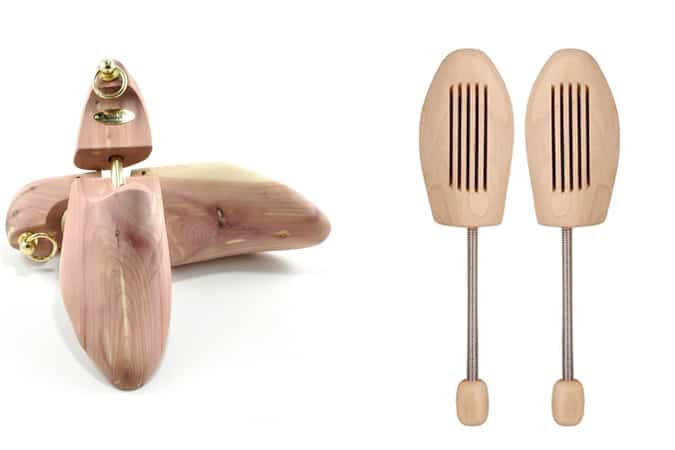
Use A Shoe Horn
Once the backs of your shoes break, they’ll never look as good. So protect them. “Always use a shoe horn when putting them on or taking them off,” says Loake. “This will keep the backs strong and sturdy.”

Clean And Polish
“Wingtips will benefit from a regular application of quality wax polish,” says Loake. “This helps to moisturize the leather, keeping it supple and helping to prevent cracking.” Wipe them clean before smearing on polish and use a toothpick to pick the excess out of the broguing, to stop gunk building up.
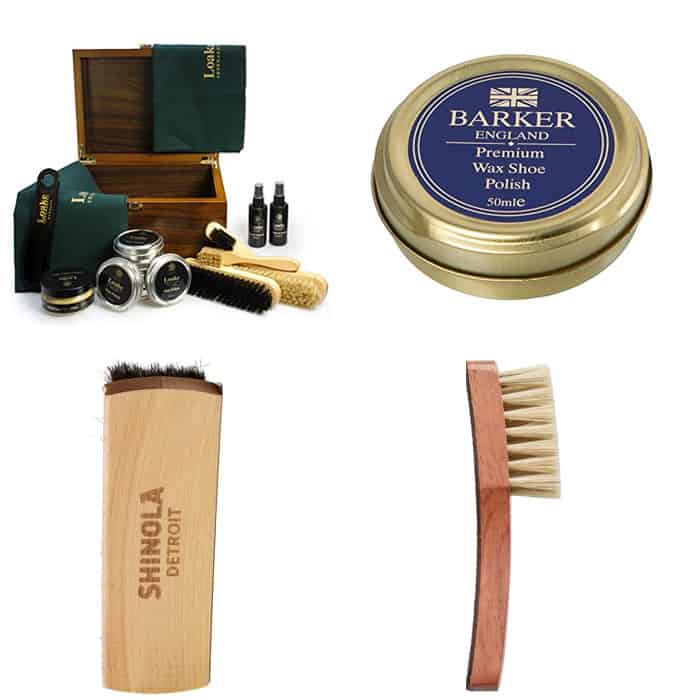
The History Of Wingtip Shoes
The wingtip was born from the brogue, which wasn’t always a shoe that one could wear to nice restaurants. “They were originally made from plaited hair and perforated, to allow water to pass in and out,” says Neil Kirkby, from Joseph Cheaney. That feature made life more pleasant for Irish farmers, who spent much of their day tramping through bogs and didn’t fancy taking the water with them. The name comes from the Gaelic word bróg, which means ‘shoe’, although ‘brogue’ didn’t enter the lexicon until the 1900s, to denote footwear you’d wear for a muddy ramble.
At first, no decent sort would attempt brogues anywhere else. But, just as brown crept into town and hats slipped off heads, society gradually accepted that having some holes in your shoes wasn’t such a crime, so long as they were deliberate. The Duke of Windsor, who in the 1920s did more than anyone else to drag men into soft tailoring and clothes with personality, even wore his on the golf course, which helped speed up their acceptance.
As they became more fashionable, shoemakers started to experiment. “The wingtip is just a toe cap in a curvy shape,” says Tim Little, owner of Grenson. “The origins of the toecap aren’t certain but the assumption is that it was originally reinforcement for the toe, to protect it from excessive wear and tear. At some point, someone made the straight toe cap into a more elegant shape, and it stuck.”
That movement from function to form, coupled with menswear’s general shift more casual, moved the wingtips from weekend to weekday too. “These days they’re obviously quite formal, although they were regarded as more casual than a straight toe cap,” says Little. “A bank manager, for example, wouldn’t wear them before the 1950s.” Nowadays, your bank manager’s probably swapped the suit for selvedge jeans and an unstructured blazer. But he’ll still be wearing wingtips.
